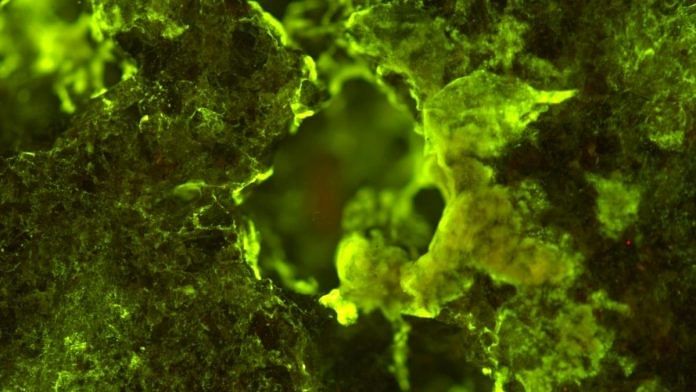Mineral mining in space could be possible due to bacteria
Experiments performed by astronauts aboard the International Space Station (ISS) suggest that bacteria can extract useful materials from rocks on Mars and the Moon.
According to the ISS team, bacteria could one day be used to break rocks down into soil for growing crops, or to provide minerals for life support systems that produce air and water.
For the study, matchbox-sized mining devices called biomining reactors were developed by scientists at the University of Edinburgh over a 10-year period. These were sent to the ISS last year.
The devices contained small pieces of basalt — a common rock on Moon and Mars — submerged in bacterial solution. After three weeks, the researchers found that bacteria could enhance the removal of rare earth elements from basalt in lunar and Martian landscapes by up to around 400 per cent.
Microbes are also routinely used on Earth in biomining to extract useful elements such as copper and gold from rocks. The new experiments have also provided new data on how gravity influences the growth of communities of microbes here on Earth, researchers say. More on the New York Times.
Also read: Jupiter’s icy moon Europa can glow in the dark even with no sun, NASA scientists find
Oldest proof of twin birth found in 31,000-year-old grave
Scientists have found that a 31,000-year-old grave of infants is the first genetically-verified and earliest proof of twin birth.
The Upper Paleolithic burials, including a double burial of two infants and the burial of a three-month-old child, were excavated in 2005 in Austria.
Archaeologists have now deciphered the relationship between the three infants, and determined the sex and age at death more precisely.
The different ages of death of the infants from the double grave, who could be identified as identical twins, confirms that reopening of a grave for reburial was a cultural-historical phenomenon at the time.
The molecular genetic analysis was able to show that the double burial involved male, identical twins.
The researchers said the fact that sufficient and high-quality old DNA could be extracted from the fragile skeletal remains for a genome analysis can be compared to a lottery ticket.
The skeletal remains of the third infant recovered from the second grave revealed that the infant was possibly a cousin of the twins. More on Livescience.
Also read: SpaceX, NASA ready first commercial taxi to space station
Atmospheric rivers driving a holes into Antarctica
Scientists have found that warm, moist rivers of air in Antarctica are creating massive holes in sea ice in a phenomenon that may influence ocean conditions around the vast continent as well as climate change.
These long, intense plumes of warm air — known as atmospheric rivers — cause sea ice holes to infrequently develop during the winter. A large hole in this area was first observed in 1973 and a hole developed again in the late winter and early spring of 2017.
Scientists have now found that repeated strong atmospheric rivers during late August through mid-September 2017 played a crucial role in forming the sea ice hole. These rivers brought warm, moist air from the coast of South America to the polar environment, warming the sea ice surface and making it vulnerable to melting.
Under future climate change, atmospheric rivers are predicted to become more frequent, longer and wider. They are also predicted to become more effective in moving high levels of water vapour towards the Antarctic Ocean. More on New Scientist.
Ancient lake bed discovered under Greenland’s thick later of ice
Researchers have discovered the remains of a huge ancient lake bed under Greenland’s thick layer of ice. This is the first-ever discovery of such a sub-glacial feature anywhere in the world.
The lake covering roughly 2,700 square miles likely formed at a time when the area was ice-free millions of years ago. It contains unique fossil and chemical traces of past climates and life.
Such data is vital to understanding what may happen to the Greenland ice sheet in the coming years as climate warms.
The researchers mapped out the lake bed by analysing data from airborne geophysical instruments that can read signals that penetrate the ice and provide images of the geologic structures below. Most of the data came from aircraft flying at low altitude over the ice sheet as part of NASA’s Operation IceBridge. More on BGR.
Also read: Netherlands study says SARS-CoV-2 virus can jump between mink and humans



